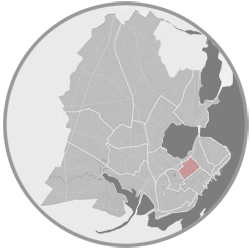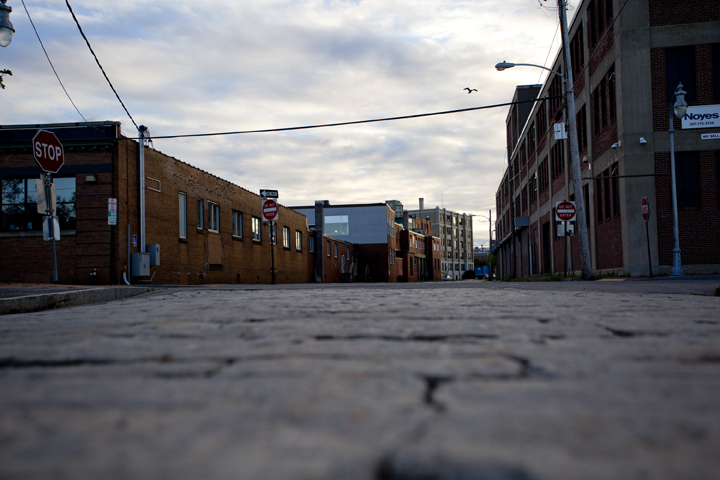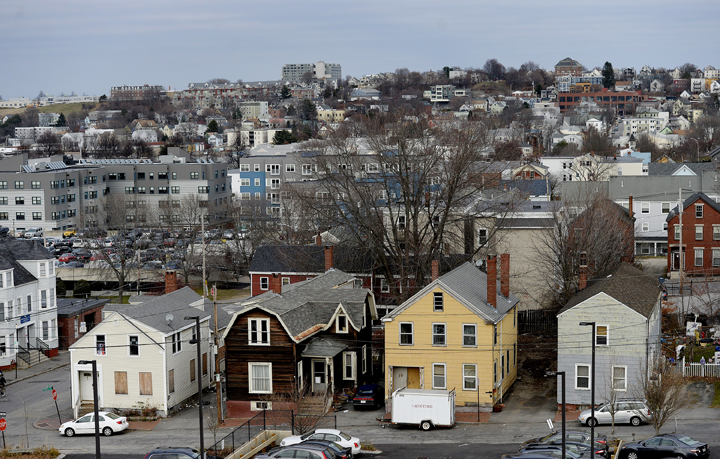WEST BAYSIDE
Tensions evident as residents live among cluster of social services. But the area is also close to downtown and businesses, creating a demand for housing that will partly be met by the $100 million Midtown project.
 In many ways, West Bayside is a neighborhood still looking to define itself.
In many ways, West Bayside is a neighborhood still looking to define itself.
Sandwiched between the bustling downtown business district and a former cluster of scrap yards, there are only a few blocks that resemble a typical residential neighborhood.
At the heart of West Bayside is a large network of social service providers, sandwiched between a two-block stretch of houses and small apartment buildings to the west and a mix of newer affordable housing complexes and older apartment buildings to the east.
West Bayside is bounded by Cumberland Avenue, Forest Avenue, Marginal Way and Franklin Street.
The tension between residents and others drawn to the neighborhood for social services is evident in numerous “No Trespassing” signs intended to keep people from loitering on steps and in alleyways. One narrow pathway behind a newer apartment building is fenced in and topped with razor wire.
Susan McCloskey, a 72-year-old freelance children’s book author and editor, has owned a two-family home on Parris Street since 1990. She rents out one unit and lives in the other with her cats.

McCloskey said West Bayside has always been “hard-scrabble,” but today there are more homeless people struggling with addiction filling the streets.
“You see more drunken behavior and I know the drug use has gone up a lot in the neighborhood,” she said. However, she also is buoyed by the number of new immigrant families putting down roots here. “It’s very nice to see the kids,” she said.
Built in 1845, McCloskey’s home is one of the few spared by the Great Fire of 1866. Two- and three-story homes lining a few leafy streets just west of the social service cluster are nestled into the hillside beneath the foreboding Back Bay Tower, a 16-story high-rise condominium complex at 389 Cumberland Ave. that was built in 1989.
Along upper Hanover and Parris streets, a series of “Bayside” placards point to the history of the neighborhood, much of which holds Greek Revival homes dating back to the 1840s and 1850s.
They tell the tale of the neighborhood’s previous residents, including Eben Seavy, the stove dealer, Gilbert L. Bailey, the gunsmith, Cyrus D. Stevens, the carriage painter, and John W. Libby, the edge tool maker.
"That's one of the amazing things about Bayside - it's incredibly central to so many things."
Stephanie Scherer bought the John W. Libby House on Hanover Street in January for $315,000. The 35-year-old print production manager for Diversified Communications lives in one half of the 155-year-old, two-family building and rents a three-bedroom unit. Scherer said she decided to live in West Bayside because it was close to downtown and it was affordable.
It’s proximity to downtown and to retailers along Forest Avenue also makes this Portland’s most walkable neighborhood, according to walkscore.com.
"That's exactly why I live here," Scherer said. "The fact that I am able to afford a house and a yard on the peninsula and I can walk to work, walk to Trader Joe's and the CVS, that kind of ability to have this compact, walkable, city-living feel was really important to me. I wasn’t ready to live out in Westbrook. That's one of the amazing things about Bayside - it's incredibly central to so many things."
A single metal scrap yard and the city’s public services operations are remaining vestiges of the area’s industrial past. Meanwhile, the now-vacant site of former scrap yards may soon give rise to a new identity for the neighborhood.
The nearly 3.5-acre city-owned parcel on Somerset Street has long been envisioned for a more than $100 million mixed-used development containing businesses and hundreds of units of market-rate housing. Midtown, as the project is known, would be the city’s largest-ever housing project and has been seen as transformational for the struggling neighborhood. It has been delayed for years by community opposition, including a lawsuit, and by disagreements with the city, but the developer now hopes to break ground before the end of 2015.
Calls to develop more housing in the neighborhood is putting pressure on the social service providers.

The anchor of social services in the neighborhood is Preble Street, which provides a day shelter and soup kitchen for the poor and homeless, as well as a teen shelter and other services. There also is a health clinic for the homeless, the city’s social services division and General Assistance offices, city-operated overnight homeless shelters for single adults and families, the Salvation Army’s Adult Rehabilitation Center, and Maine Behavioral Healthcare, among others.
Both longtime and new residents said that having so many social services in one area – although needed – is a drag on their neighborhood. Residents grow weary of having to call police and pick up used hypodermic needles left behind by drug users who presumably were passing through the area to get food, shelter or some other service.
However, decades ago, Preble Street was strongly encouraged to become an anchor for social services in the Bayside neighborhood, said Executive Director Mark Swann.
“We put roots down in this neighborhood when nobody else would,” he said.
Although the agency now feels pressure from developers and Realtors to leave the neighborhood, Swann said he believes Preble Street fills a vital role and has long tried to be a good neighbor, conducting neighborhood cleanups and addressing problems as they arise.
“We were encouraged to be in this neighborhood before this wave of gentrification rolled down upon us,” Swann said. “Obviously a lot has changed, and it is seen as an area ripe for investment.”


WEST BAYSIDE FROM ABOVE
A video camera mounted on an FAA approved, remote-controlled drone provides an unusual view of Portland’s rental neighborhoods.
© 2015 MaineToday Media | Originally published Dec. 29, 2015
